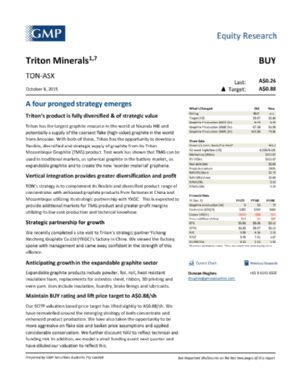
Significant High-Grade Graphite Intersected at Nicanda Hill
Perth, June 23, 2014 AEST (ABN Newswire) - Triton Minerals Ltd ( ASX:TON) ("Triton", "the Company") is extremely pleased to confirm that the first round of assay results from the RC drilling program, has identified multiple high grade zones of the graphite mineralisation at Nicanda Hill. Further, based on geological observations, that the Company has once again intersected significant graphitic mineralization at considerable depths.
ASX:TON) ("Triton", "the Company") is extremely pleased to confirm that the first round of assay results from the RC drilling program, has identified multiple high grade zones of the graphite mineralisation at Nicanda Hill. Further, based on geological observations, that the Company has once again intersected significant graphitic mineralization at considerable depths.
Triton Minerals Managing Director Brad Boyle said "To intercept a further 313m cumulative width of graphite mineralisation in a single hole and still open at depth, some 500m south east from the last major interception is an astounding result.
Further, the latest assay results are demonstrating that the Nicanda Hill prospect mineralisation contains multiple high grade graphite zones averaging 11% graphite carbon. These are very exciting results for Triton and continues to show the world class potential of the Balama North project."
SIGNIFICANT ASSAY RESULTS FROM FIRST RC DRILLHOLE
Triton has completed nineteen (19) RC drill holes and five (5) diamond holes in the current drilling program on the Nicanda Hill prospect that has been designed to test the width and potential continuity of the interpreted graphitic zone as suggested by the conductive zones identified in VTEM data (Figure 5 in link below).
The initial assay results for RC drill hole GBNC0003 have been received and are shown in Figure 1 and Table 1 in link below. The 153m long drill hole GBNC0003, contains a cumulative thickness of 125m of graphitic schist.
Due to the consistently high graphite grades that have been received from the Nicanda Hill prospect to date, the assay results are now being reported at both 5%GrC and 10%GrC cut offs.
Significantly, at a 5%GrC cut off, GBNC0003 has returned 78m at 11.4%GrC. Within this 78m intersection are four high grade intervals at a 10%GrC cut off, which include 20m at 17.1%GrC. The geological unit from which returned the intercept of 20m at 17.1%GrC has been designated as the HG1 zone (Figure 1 in link below).
POTENTIAL OF THE HG1 ZONE
Geologically, the HG1 zone is defined by a graphitic schist that comprises a quartz-graphite-carbonate mineral assemblage. HG1 was intersected by diamond drill holes TMBD0005 and TMBD0006 that were completed in November 2013, and recently HG1 has been identified in a number of the 2014 drill holes. At a 10%GrC cut off, these holes reported 30m at 17.6%GrC and 22.7m at 16.9%GrC respectively (Figure 2 in link below).
Thus, HG1 has returned significant graphite carbon assay results from three holes on two sections separated by 200m along strike.
Diamond drill hole GBND0001, on section N2, has intersected the identical rock type that defines HG1 at a point that is 145m down dip from TMBD0006. The HG1 zone in GBND0001 is developed over a downhole interval of 34m from 181m. Assay results are pending.
HG1 has also been intersected in diamond drillhole GBND0003 (S1.5) from 33m to 77m downhole (refer plan, Figure 3 in link below). Assays are pending. This intersection confirms the geological continuity of HG1 is over a strike length of 540m.
The oriented diamond core from drill holes TMBD0005, TMBD0006 and GBND0001 to GBND0005 shows the graphite schist generally dips to the northwest with local folding evident. On this basis, the Company believed that the graphite mineralisation potential continued down dip to the northwest to considerably greater depths than already intersected in GBND0005 (428.6m total hole depth).
Thus diamond hole GBND0005 was designed, on section S1, to test as much of the graphitic stratigraphy as possible.
GBND0005, which ended at a depth of 428m, contains a cumulative thickness of 313m of graphitic schist, the remainder comprising narrow intervals of non-graphitic tonalite gneiss. The hole was terminated in graphite schist leaving the hole open at depth (Figure 4 in link below).
Significantly, GBND0005 together with GBNC0002 and GBNC0009, have all intersected the identical rocks that define the target HG1 zone. On section S1 the HG1 zone has been geologically interpreted to be continuous from near surface to beyond the depths identified in diamond drill hole GBND0005 - a down dip extent of over 500m and a strike length of 540m as previously stated. Assays from these three holes are pending.
KEY POINTS
- The reported results continue to demonstrate multiple high grade graphite zones of substantial widths along the entire length of all drillholes completed to date.
- Further, these results have verified the continutity and consistency of previously identified high grade zones.
- High grade target zone (HG1) confirmed over a strike length of 540m and 500m downdip.
- The assay results to date are demonstrating average grades for HG1 of above 17% graphitic carbon.
- These latest observations dramatically expand the known mineralisation zone and demonstrates good continuity and consistency in the graphite mineralisation over a considerable distance.
- The drilled graphite mineralization intersections correlate well with the zone of high electrical conductivity defined by the VTEM survey data. The inversion modelling of the VTEM data interpreted the graphite mineralisation to extend well beyond 150m depth below surface.
ONGOING EXPLORATION
Presently the drilling has demonstrated a width of over 850m of graphite mineralisation at surface (extended with GBNC0016) and over 400m vertically. Additional holes are planned to the northwest of hole GBNC0007, to close off the zone of graphite mineralisation on drill line N2.
The deep intersections of graphite mineralisation in GBND0001 and GBND0005 lends further support to this interpretation. Graphite mineralisation to these depths exceed the Company's original target expectations and the Company is excited by the fact that the zone still remains open to the northwest.
Furthermore, the Company is yet to drill on of the ridge of Nicanda Hill, which recent survey data confirms has an elevation of more than 90m above the collars of the drilled holes.
To date the trenching and drilling at Nicanda Hill Prospect has demonstrated graphite mineralization over 1.75km between drill line S1 and Trench 2 (Figure 5 in link below). The Company is looking to extend the known extents of the graphite mineralisation on the Nicanda Hill Prospect with further drill testing of the 5km long high electrical conductivity zone defined by the VTEM survey data.
These drilling results have again dramatically expand the depths and width of the defined graphite mineralization zone on the Nicanda Hill Prospect, with the zone remaining open to the north, south and west.
BALAMA NORTH GRAPHITE
The drilling program at Nicanda has also continued to support the Company's view that the graphite liberates readily from the graphitic material. As previously announced by Triton on 15 April 2014, the graphite was liberated by proven methods of crushing, grinding, rougher and cleaner flotation, to obtain high grade graphite concentrate of up to 97.1%. An example of the flotation method is shown in Figure 6 in link below.
Triton notes the similarity of the flotation results and the recovery of graphite as obtained in the ALS laboratory, to the occurs of graphite liberation seen with the diamond drill holes at Nicanda Hill (Figure 7 in link below).
The liberation of the graphite during the drilling process is a very encouraging sign of the presence of high grade graphite zones. Triton feels that the graphite at Nicanda Hill also appears to be readily liberated using the same methods as Cobra Plains, thus the likelihood of obtaining high grade graphite concentrate in the future is also good.
IMPLICATIONS
These drilling results continue to demonstrate that the Balama North project can potentially host a market leading and world class high grade graphite deposit and could become one of largest high-grade graphite projects in the world.
The strategy of testing the full stratigraphic width and downdip extensions enables the Company to assess the scale of the deposit in order to better plan for resource-conversion drill spacing and the targeting of higher quality mineralization that may amenable to open pit extraction.
Triton is extremely confident of continued exploration success and is looking forward to providing further exploration updates to the market, as the information becomes available.
To view all figures and tables, please visit:
http://media.abnnewswire.net/media/en/docs/ASX-TON-681580.pdf
About Triton Minerals Ltd
 Triton Minerals Limited (ASX:TON) is an ASX listed, responsible mineral explorer and resource management company headquartered in Perth, Australia.
Triton Minerals Limited (ASX:TON) is an ASX listed, responsible mineral explorer and resource management company headquartered in Perth, Australia.
Led by a highly experienced management team, Triton Minerals' vision is to grow shareholder's value through discovery or development of base metal, gold and other precious metal deposits.
Triton has made excellent progress with its three Graphite projects located in the Cabo Delgado Province in Mozambique, with the program successfully identifying a number of graphitic exposures.
It is the Company's belief that the Mozambique, Balama North Project could host multiple and very substantial world class graphite deposits.
| ||
|














